Fe-Co-B Soft Magnetic Ribbons: Crystallization Process, Microstructure and Coercivity
Abstract
:1. Introduction
2. Materials and Methods
3. Results and Discussion
3.1. Characterization of the as Spun Fe67Co20B13 Ribbon
3.2. In Situ TEM Heating Observations
3.3. Characterization of Heat Treated Fe67co20B13 Ribbons
3.4. Magnetic Properties
4. Conclusions
Author Contributions
Funding
Conflicts of Interest
References
- Hou, Y.; Sellmyer, D.J. Magnetic Nanomaterials: Fundamentals, Synthesis and Applications; John Wiley & Sons: Hoboken, NJ, USA, 2017; ISBN 978-3-527-34134-4. [Google Scholar]
- Gavrila, H.; Ionita, V. Crystalline and amorphous soft magnetic materials and their applications—Status of art and challenges. J. Optoelectron. Adv. Mater. 2002, 4, 173–192. [Google Scholar]
- Herzer, G. Modern soft magnets: Amorphous and nanocrystalline materials. Acta Mater. 2013, 61, 718–734. [Google Scholar] [CrossRef]
- Inoue, A.; Shen, B.; Koshiba, H.; Kato, H.; Yavari, A.R. Cobalt-based bulk glassy alloy with ultrahigh strength and soft magnetic properties. Nat. Mater. 2003, 2, 661–663. [Google Scholar] [CrossRef] [PubMed]
- Yoshizawa, Y.; Oguma, S.; Yamanchi, K. New Febased soft magnetic alloys composed of ultrafine grain structure. J. Appl. Phys. 1998, 64, 6044–6046. [Google Scholar] [CrossRef]
- Kong, F.; Shen, B.; Mahino, A.; Inoue, A. Enhancement of soft magnetic properties of FeCoNbB nanocrystalline alloys with Cu and Ni additions. Thin Solid Films 2011, 519, 8280–8282. [Google Scholar] [CrossRef]
- Dong, C.; Inoue, A.; Wang, X.H.; Kong, F.L.; Zanaeva, E.N.; Wang, F.; Bazlov, A.I.; Zhu, S.L.; Li, Q. Soft magnetic properties of Fe82-83B14-15Si2C0.5-1 amorphous alloys with high saturation magnetization above 1.7 T. J. Non-Cryst. Solids 2018, 500, 173–180. [Google Scholar] [CrossRef]
- Sharma, P.; Zhang, X.; Zhang, Y.; Makino, A. Atomic packing and diffusion in Fe85Si2B9P4 amorphous alloy analyzed by ab initio molecular dynamics simulation. J. Appl. Phys. 2015, 117, 17B705. [Google Scholar]
- Akase, Z.; Aizawa, S.; Shindo, D.; Sharma, P.; Makino, A. In-situ Lorentz microscopy of Fe85Si2B8P4Cu1 nanocrystalline soft magnetic alloys. J. Magn. Magn. Mater. 2015, 375, 10–14. [Google Scholar] [CrossRef]
- Herzer, G. Soft magnetic nanocrystalline materials. Scr. Metall. Mater. 1995, 33, 1741–1756. [Google Scholar] [CrossRef]
- Herzer, G. Nanocrystalline Soft Magnetic Materials. Phys. Scr. 1993, 1993, 307. [Google Scholar] [CrossRef]
- Hsiao, A.; McHenry, M.E.; Laughlin, D.E.; Kramer, M.J.; Ashe, C.; Ohkubo, T. The Thermal, Magnetic, and Structural Characterization of the Crystallization Kinetics of Fe88Zr7B4Cu1, an Amorphous Soft Magnetic Ribbon. IEEE Trans. Magn. 2002, 38, 3039–3044. [Google Scholar] [CrossRef]
- Pradeep, K.G.; Herzer, G.; Choi, P.; Raabe, D. Atom probe tomography study of ultrahigh nanocrystallization rates in FeSiNbBCu soft magnetic amorphous alloys on rapid annealing. Acta Mater. 2014, 68, 295–299. [Google Scholar] [CrossRef]
- Zhang, Z.; Sharma, P.; Makino, A. Role of Si in high Bs and low core-loss Fe85.2B10−XP4Cu0.8SiX nano-crystalline alloys. J. Appl. Phys. 2012, 112, 103902. [Google Scholar] [CrossRef]
- Suzuki, K.; Makino, A.; Inoue, A.; Masumoto, T. Low core losses of nanocrystalline Fe–M–B (M = Zr, Hf, or Nb) alloys. J. Appl. Phys. 1993, 74, 3316–3322. [Google Scholar] [CrossRef]
- Cao, C.C.; Zhu, L.; Meng, Y.; Zhai, X.B.; Wang, Y.G. Atomic level structural modulation during the structural relaxation and its effect on magnetic properties of Fe81Si4B10P4Cu1 nanocrystalline alloy. J. Magn. Magn. Mater. 2018, 456, 274–280. [Google Scholar] [CrossRef]
- Ohta, M.; Yoshizawa, Y. Effect of Heating Rate on Soft Magnetic Properties in Nanocrystalline Fe80.5Cu1.5Si4B14 and Fe82Cu1Nb1Si4B12 Alloys. Appl. Phys. Express 2009, 2, 023005. [Google Scholar] [CrossRef]
- Herzer, G. Grain structure and magnetism of nanocrystalline ferromagnets. IEEE Trans. Magn. 1989, 25, 3327–3329. [Google Scholar] [CrossRef]
- Zhang, Y.; Sharma, P.; Makino, A. Sintered magnetic cores of high Bs Fe84.3Si4B8P3Cu0.7 nano-crystalline alloy with a lamellar microstructure. J. Appl. Phys. 2014, 115, 17A322. [Google Scholar] [CrossRef]
- Sato, K.; Takenaka, K.; Makino, A.; Hirotsu, Y. Direct imaging of structural heterogeneity of the melt-spun Fe85.2Si2B8P4Cu0.8 alloy. AIP Adv. 2015, 5, 067166. [Google Scholar] [CrossRef] [Green Version]
- Sharma, P.; Zhang, X.; Zhang, Y.; Makino, A. Competition driven nanocrystallization in high Bs and low coreloss Fe–Si–B–P–Cu soft magnetic alloys. Scr. Mater. 2015, 95, 3–6. [Google Scholar] [CrossRef]
- Han, Y.; Inoue, A.; Kong, F.L.; Chang, C.T.; Shu, S.L.; Shalaan, E.; Al-Marzouki, F. Softening and good ductility for nanocrystal-dispersed amorphous Fe–Co–B alloys with high saturation magnetization above 1.7 T. J. Alloys Compd. 2016, 657, 237–245. [Google Scholar] [CrossRef]
- Stergioudis, G.; Ivanov, G.; Polychroniadis, E.K. Evolution of Crystallization of the FeCoB Amorphous Alloys. Phys. Status Solidi 1991, 124, 393–399. [Google Scholar] [CrossRef]
- Chulist, R.; Straka, L.; Seiner, H.; Sozinov, A.; Schell, N.; Tokarski, T. Branching of {110) twin boundaries in five-layered Ni-Mn-Ga bent single crystals. Mater. Des. 2019, 171, 107703. [Google Scholar] [CrossRef]
- Kulik, T.; Sevage, H.T.; Hernando, A. A high-performance hysteresis loop tracer. J. Appl. Phys. 1993, 73, 6855–6857. [Google Scholar] [CrossRef]




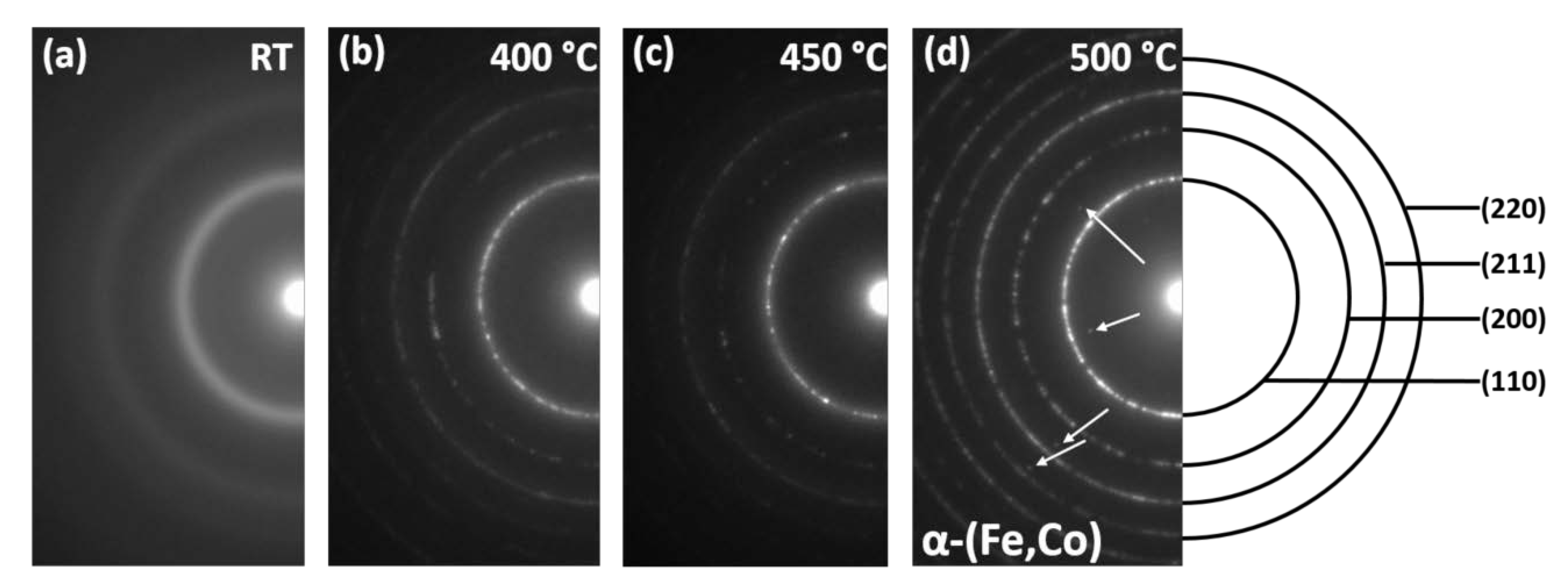
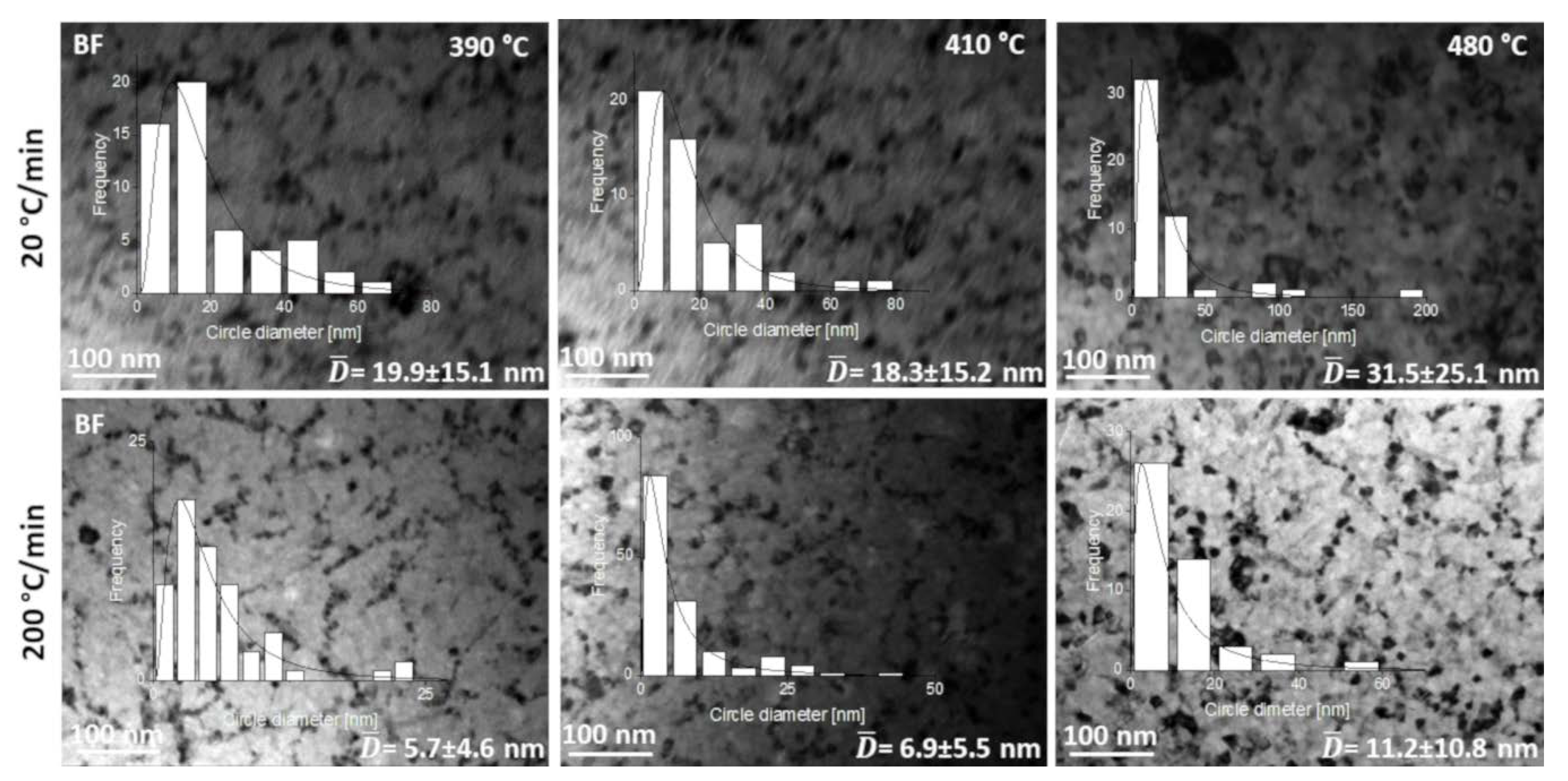
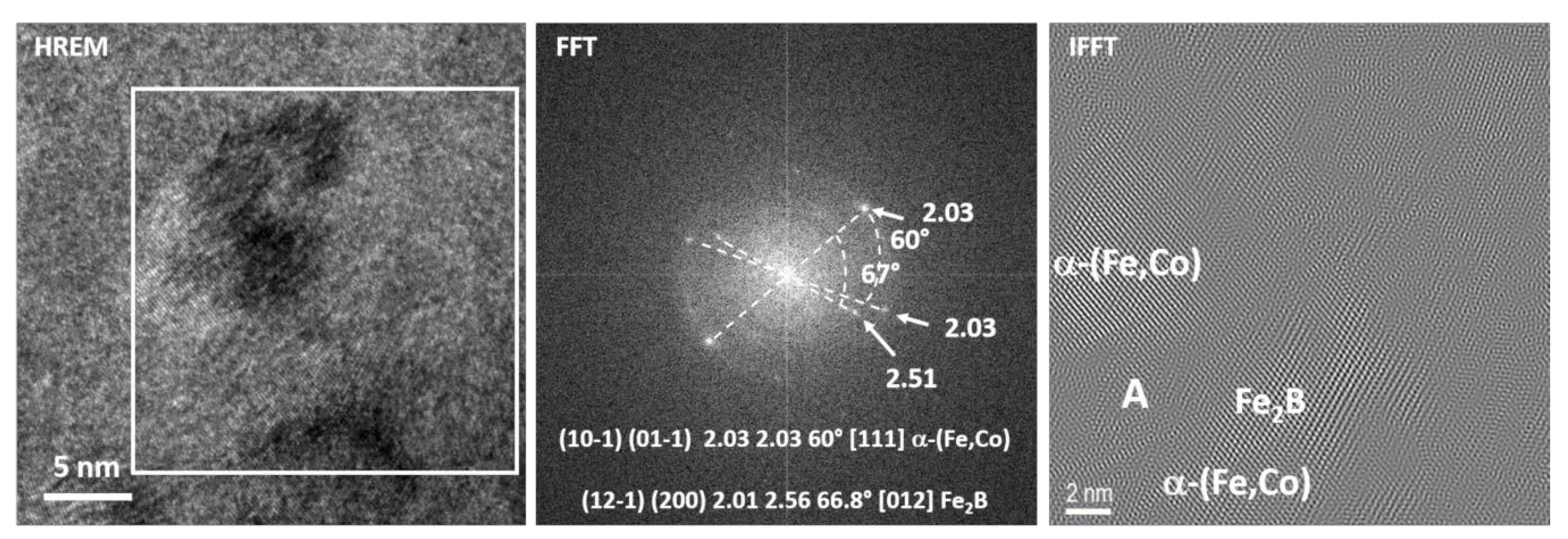
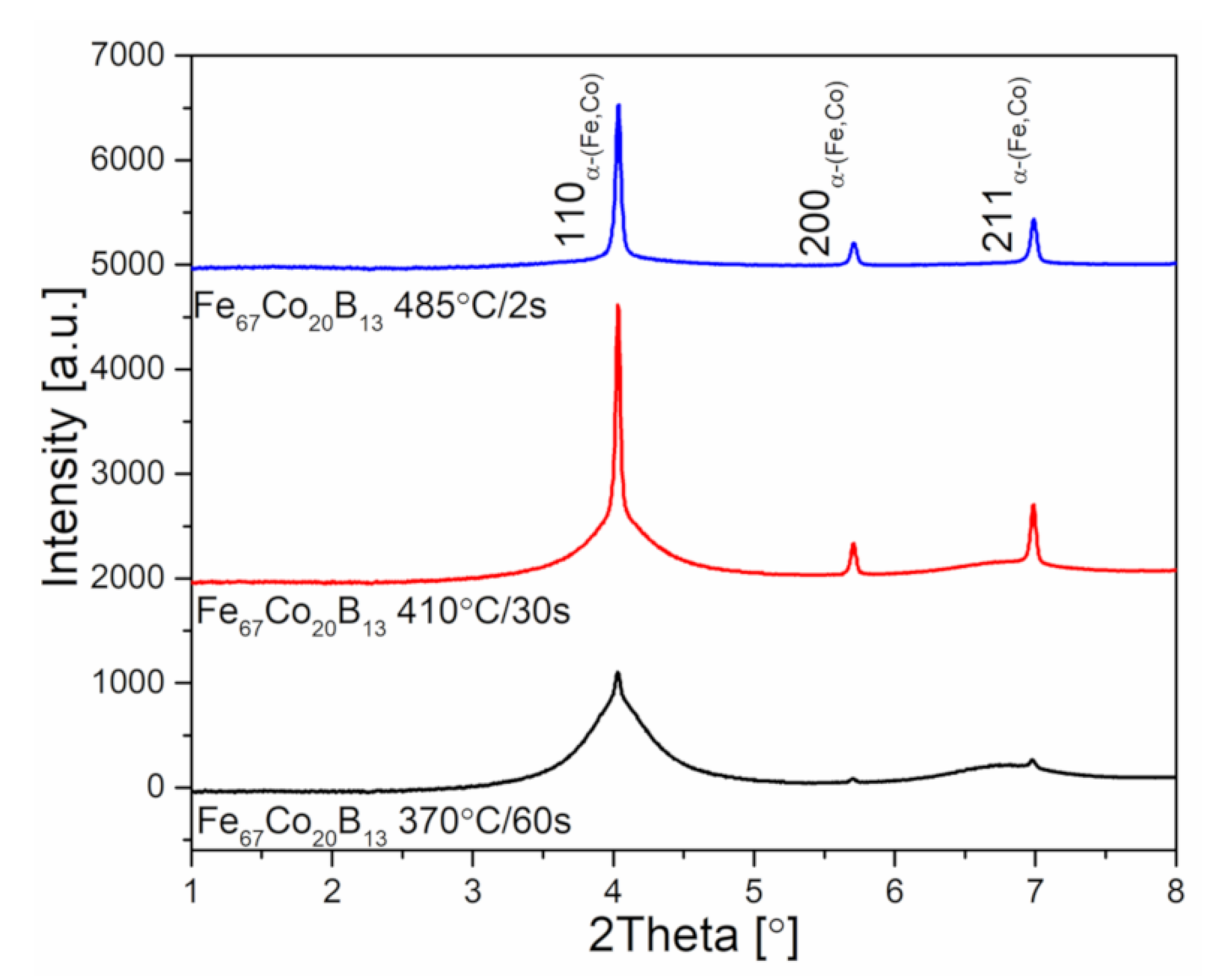
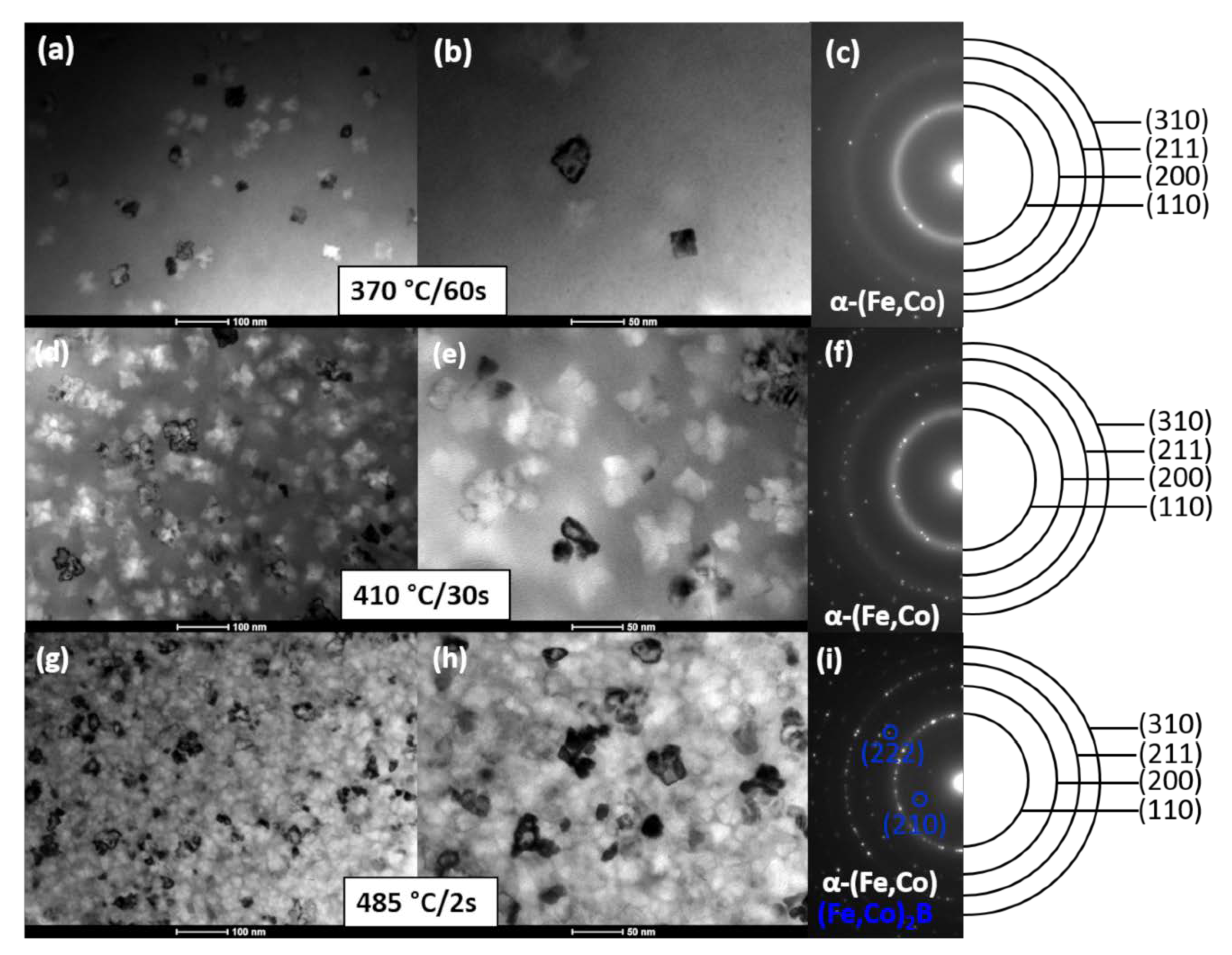
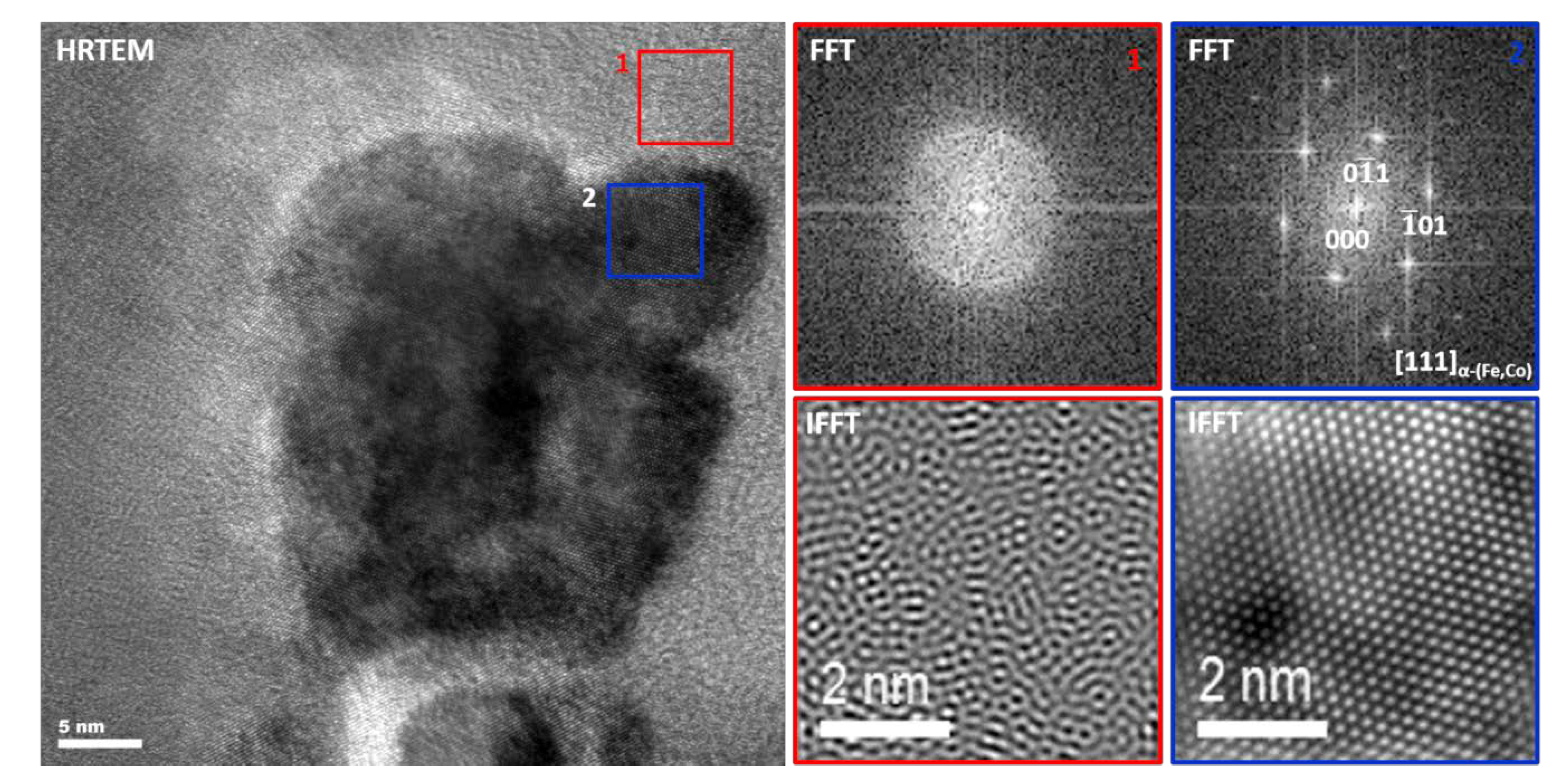
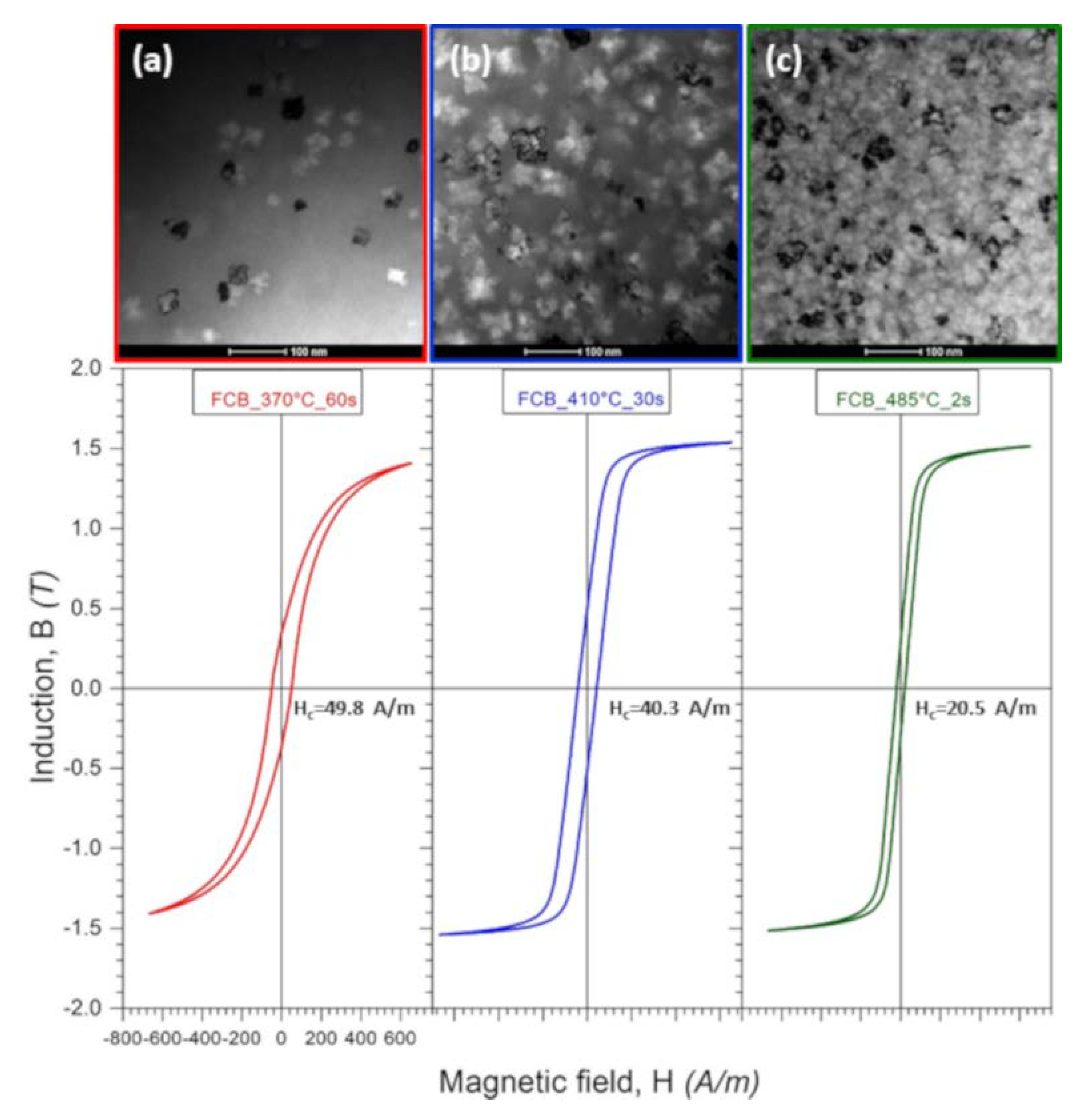
© 2020 by the authors. Licensee MDPI, Basel, Switzerland. This article is an open access article distributed under the terms and conditions of the Creative Commons Attribution (CC BY) license (http://creativecommons.org/licenses/by/4.0/).
Share and Cite
Wojcik, A.; Maziarz, W.; Kowalczyk, M.; Chulist, R.; Szlezynger, M.; Czaja, P.; Hawelek, L.; Zackiewicz, P.; Wlodarczyk, P.; Kolano-Burian, A. Fe-Co-B Soft Magnetic Ribbons: Crystallization Process, Microstructure and Coercivity. Materials 2020, 13, 1639. https://doi.org/10.3390/ma13071639
Wojcik A, Maziarz W, Kowalczyk M, Chulist R, Szlezynger M, Czaja P, Hawelek L, Zackiewicz P, Wlodarczyk P, Kolano-Burian A. Fe-Co-B Soft Magnetic Ribbons: Crystallization Process, Microstructure and Coercivity. Materials. 2020; 13(7):1639. https://doi.org/10.3390/ma13071639
Chicago/Turabian StyleWojcik, Anna, Wojciech Maziarz, Maciej Kowalczyk, Robert Chulist, Maciej Szlezynger, Pawel Czaja, Lukasz Hawelek, Przemyslaw Zackiewicz, Patryk Wlodarczyk, and Aleksandra Kolano-Burian. 2020. "Fe-Co-B Soft Magnetic Ribbons: Crystallization Process, Microstructure and Coercivity" Materials 13, no. 7: 1639. https://doi.org/10.3390/ma13071639




